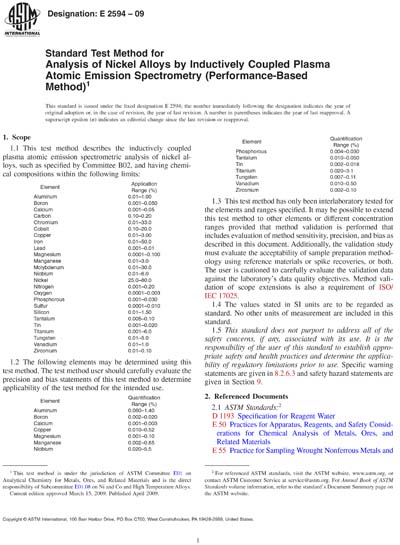Historical
ASTM E2594-09
Standard Test Method for Analysis of Nickel Alloys by Inductively Coupled Plasma Atomic Emission Spectrometry (Performance-Based Method)
1.1 This test method describes the inductively coupled plasma atomic emission spectrometric analysis of nickel alloys, such as specified by Committee B02, and having chemical compositions within the following limits:
| Element | Application Range (%) |
|---|---|
| Aluminum | 0.01–1.00 |
| Boron | 0.001–0.050 |
| Calcium | 0.001–0.05 |
| Carbon | 0.10–0.20 |
| Chromium | 0.01–33.0 |
| Cobalt | 0.10–20.0 |
| Copper | 0.01–3.00 |
| Iron | 0.01–50.0 |
| Lead | 0.001–0.01 |
| Magnesium | 0.0001–0.100 |
| Manganese | 0.01–3.0 |
| Molybdenum | 0.01–30.0 |
| Niobium | 0.01–6.0 |
| Nickel | 25.0–80.0 |
| Nitrogen | 0.001–0.20 |
| Oxygen | 0.0001–0.003 |
| Phosphorous | 0.001–0.030 |
| Sulfur | 0.0001–0.010 |
| Silicon | 0.01–1.50 |
| Tantalum | 0.005–0.10 |
| Tin | 0.001–0.020 |
| Titanium | 0.001–6.0 |
| Tungsten | 0.01–5.0 |
| Vanadium | 0.01–1.0 |
| Zirconium | 0.01–0.10 |
1.2 The following elements may be determined using this test method. The test method user should carefully evaluate the precision and bias statements of this test method to determine applicability of the test method for the intended use.
| Element | Quantification Range (%) |
|---|---|
| Aluminum | 0.060–1.40 |
| Boron | 0.002–0.020 |
| Calcium | 0.001–0.003 |
| Copper | 0.010–0.52 |
| Magnesium | 0.001–0.10 |
| Manganese | 0.002–0.65 |
| Niobium | 0.020–5.5 |
| Phosphorous | 0.004–0.030 |
| Tantalum | 0.010–0.050 |
| Tin | 0.002–0.018 |
| Titanium | 0.020–3.1 |
| Tungsten | 0.007–0.11 |
| Vanadium | 0.010–0.50 |
| Zirconium | 0.002–0.10 |
1.3 This test method has only been interlaboratory tested for the elements and ranges specified. It may be possible to extend this test method to other elements or different concentration ranges provided that method validation is performed that includes evaluation of method sensitivity, precision, and bias as described in this document. Additionally, the validation study must evaluate the acceptability of sample preparation methodology using reference materials or spike recoveries, or both. The user is cautioned to carefully evaluate the validation data against the laboratory’s data quality objectives. Method validation of scope extensions is also a requirement of ISO/IEC 17025.
1.4 The values stated in SI units are to be regarded as standard. No other units of measurement are included in this standard.
1.5 This standard does not purport to address all of the safety concerns, if any, associated with its use. It is the responsibility of the user of this standard to establish appropriate safety and health practices and determine the applicability of regulatory limitations prior to use. Specific warning statements are given in 8.2.6.3 and safety hazard statements are given in Section 9.
ASTM International [astm]

